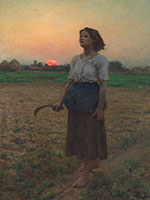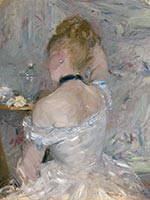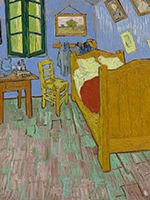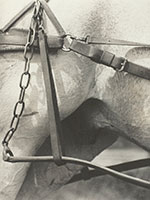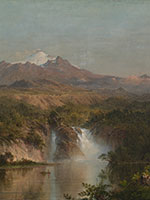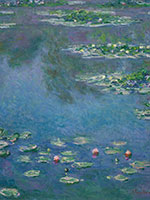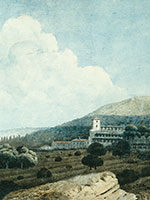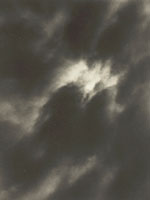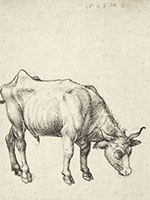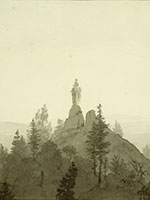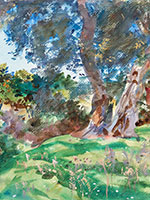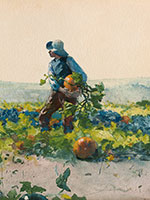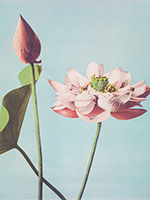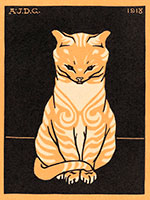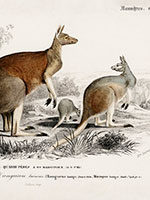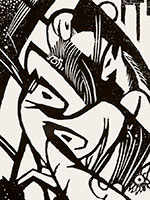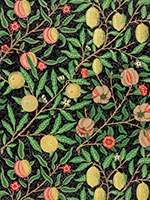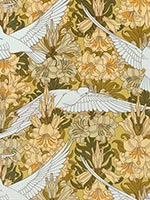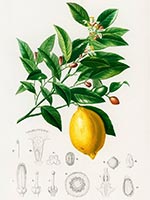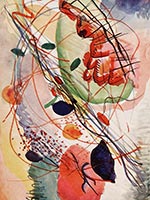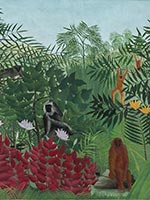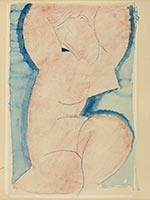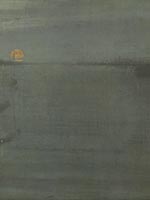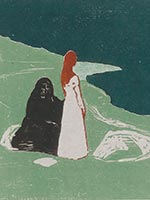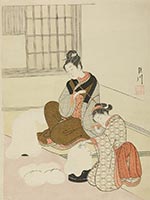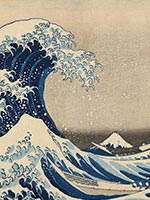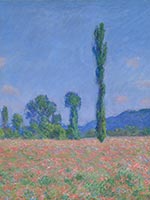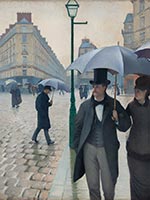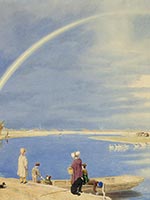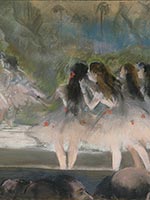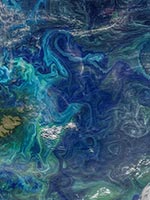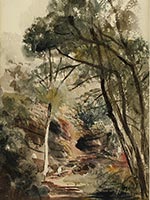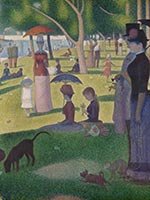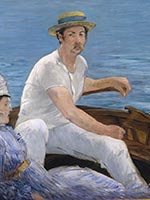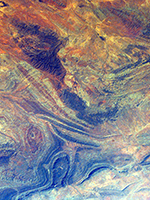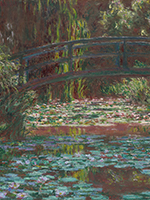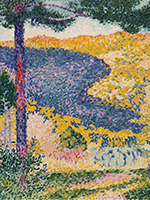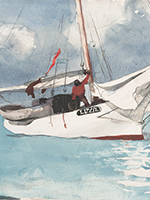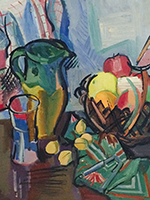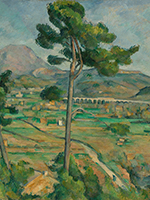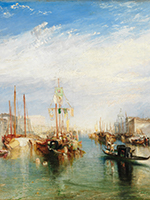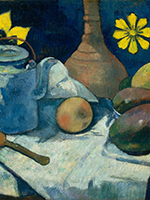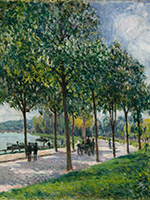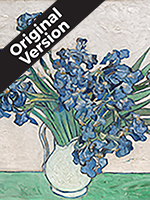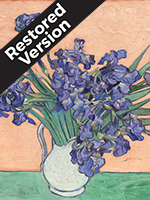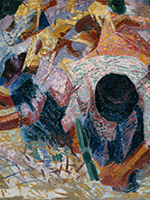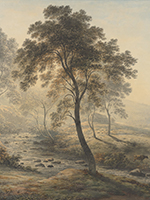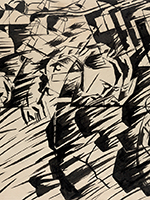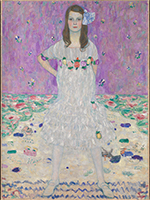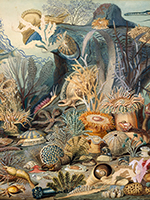Artwork of the Week
Artwork of the Week is a series of weekly emails we send of public domain art pieces curated by our team for you. Handpicked by PosterFactory these artworks are specifically chosen to print on our premium papers to produce stunning art prints with exceptional image reproduction.
A 19th-century French Naturalist painter whose paintings are heavily influenced by the French countryside and his absorption of traditional painting methods helped make Jules Breton one of the primary transmitters of the beauty and idyllic vision of rural existence.
She is one of the most influential painters of the French Impressionist school of art. In 1864, Morisot exhibited in the highly esteemed Salon de Paris for the first time. Her delicate and subtle style won her the respect and praise of her colleagues, but she was denied international recognition until long after her death.
Vincent Willem van Gogh was a Dutch Post-Impressionist painter who posthumously became one of the most famous and influential figures in Western art history. He created about 2,100 artworks in a decade, including around 860 oil paintings, most of which date from the last two years of his life.
Founder of the photo-secessionist and pictorialist photography movements in the United States, Alfred Stieglitz was a pioneer photographer and avid promoter of the modern arts. With a career lasting over 50 years, Stieglitz refused to sell his photographs and instead made money through awards, exhibitions, and as a writer of the art.
Frederic E. Church was an American landscape painter best known for his large landscape paintings portraying mountains, waterfalls, and sunsets. As a romantic, Frederic depicted nature in idealized scenes of richness and beauty, emphasizing its grand scale.
That’s how Monet referred to the series of his late masterpieces produced at his home — the famous water landscapes from his Giverny gardens. Monet’s late work between 1897 and his death in 1926 had a single, timeless motif, water lilies.
Claude Monet was the leader of the French Impressionist movement. Interested in painting in the open air and capturing natural light, Monet would later bring the technique to one of its most famous pinnacles — his series paintings. Monet would paint the same subject at different times, capturing the different colours and tones.
Pupil of Richard Wilson, Thomas Jones was a Welsh landscape painter. Best known in his lifetime by painting Welsh and Italian landscapes, Jones became famous only in the 20th century when some of his unconventional paintings were found.
Founder of the photo-secessionist and pictorialist photography movements in the United States, Alfred Stieglitz was a pioneer photographer and avid promoter of the modern arts. With a career lasting over 50 years, Stieglitz refused to sell his photographs and instead made money through awards, exhibitions, and as a writer of the art.
This crayon lithograph depicts a black cat and a white cat on a rooftop under a moonlit sky. This 19th-century print showcases the use of positive and negative space, almost illustrating a Yin Yang — a Chinese philosophy of opposite energies that are complementary. This clash of light and dark when well planned creates a sense of balance instead of chaos.
Édouard Manet was one of the first artists to paint ‘modern life’ and an influential figure in the artistic shift from realism to impressionism. Manet was brought up in an upper-class household but led a bohemian life — causing frequent scandals amongst refined French society.
Manet has long been associated with the Impressionists; but recently, critics have acknowledged he also studied and applied techniques from French realism and naturalism as well as 17th-century Spanish painting.
Dürer was an influential German painter, printmaker, and theorist of the German Renaissance who established a reputation across Europe in his early ages through his woodcut work. Connected with the major Italian artists of his time, such as Raphael, Bellini, and da Vinci, Dürer was introduced to classical motifs that helped him secure his reputation as one of the most important figures of the Northern Renaissance.
Caspar David Friedrich was one of the most prominent German Romantic landscape painters of the 19th century. Known for his landscapes, like the “Statue of the Madonna in the Mountains”, his paintings usually contemplates silhouetted figures, nature, with more subjective and emotional response to nature than classical art.
One of the most sought-after portraitists of his era, John Sargent was known for his powerful and vibrant portraits — and yet he excelled in a variety of genres like watercolours, landscapes, just like this painting. His ability to straddle the line between tradition and the avant-garde highly impressed his audience and collectors.
Homer was an American landscape painter and printmaker, mostly known for his marine oil paintings. While he began his career as a commercial illustrator, he painted watercolour landscapes during his vacations — a technique he continued to deploy as sketches for his mature oil work. Homer became notorious for his distinct oil paintings and various subject matters, reaching financial stability right before passing in 1910.
The original version of Lotus Flowers appears in the coloured photography album called “Some Japanese Flowers,” which features a collection of Ogawa’s work. The image subsequently appeared in “Japan,” published in 1897 and contains contributions from a collection of Japanese authorities and scholars. The close-up flowers are delicately hand-painted to bring out the fragile, fleeting beauty of lotus flowers, while the subtle pinks and greens suggest a definite Art Nouveau influence.
Ogawa Kazumasa (also known as Ogawa Kazuma or Ogawa Isshin) was a Japanese printer, photographer and publisher who pioneered photomechanical printing and photography. He was born in Saitama before moving to Tokyo to improve his (already excellent) English and then moving to Boston.
Ogawa moved back to Japan in 1884 and founded a dry photographic plate manufacturing company, and set up the country’s first collotype business. Ogawa was also a founding member of the Japan Photographic Society and was commissioned to take 100 photos of Tokyo’s most attractive Geisha in 1891.
Owners who get to know their cats eventually distinguish exactly these kinds of symmetrical markings that, to a casual viewer, look random — but here they are made prominent for everyone to appreciate.
De Graag’s cat sits in a very formal pose with its tail over two primly placed front paws — its head bowed just enough suggest that it’s hoping for a pat from its owner, but won’t beg for attention if it’s not forthcoming. How very cat-like!
Julie de Graag was a Dutch artist, illustrator and painter who trained at the The Hague’s Royal Academy of Art and became the protégé of HP Bremmer, a famous Dutch painter, teacher and art critic. She was a prolific artist but, as her home burned down in 1908, much of her work has been lost.
De Graag suffered from mental and physical illness throughout her life and both deteriorated in the early 1920s — the results of which were reflected in her work. Julie de Graag tragically took her own life at just 46 years old, leaving us with some beautifully stylised animal studies, flowers, portraits, and wood cuts by which to remember her.
Charles Henry Dessalines d’Orbigny was a French geologist and botanist. He was the younger brother of Alcide d’Orbingny, a famous explorer of South America and a renowned French naturalist. Working at Paris’ National Museum of Natural History, d’Orbigny identified and catalogued many of the flowers and plants returned that his brother brought home from his adventures. In 1834, he succeeded Louis Cordier as the museum’s principal geologist. He continued to work there until illness forced him to retire three decades later.
This primal style also links back to Marc’s view that animals retain an innocence that humanity has now lost. Later in his career, Marc changed his mind on this point and saw all creation as flawed — even ugly. With no whites in their eyes, these horses may well be the unconscious start of those feelings and Marc’s ultimate wish for the coming war to purify the world through destruction and then rebirth.
Franz Marc was a German painter and print-maker who, despite dying at just 36, had an incredible influence on Expressionism. During his life, he explored naturalism, realism, symbolism and abstraction. He founded a Der Blaue Reiter, a pioneering German Expressionist movement that focused on art’s spiritual value and impact. Towards the end of his life, as the First World War loomed, Marc’s painting began to reflect his anxiety and the uncertain fate that awaited Europe. Tragically, Marc died fighting as a cavalryman in WWI at the Battle of Verdun on March 4, 1916.
The pomegranates, which are repeated regularly in the print, would have been considered particularly exotic and, like the pineapples that were so in vogue during Morris’ era, conveyed wealth, status and power.
Our version of ‘Fruit’ is printed on a black background, but Morris produced the same design on green, pink, brown, light grey or navy backgrounds too.
An English gentleman, William Morris trained as a priest and then an architect but ultimately found his vocation as a painter, designer and writer. He is often considered to be the founder of the Arts and Crafts Movement, which spanned painting, drawing, craft, philosophy and literature.
The movement’s socialist utopia (which Morris wrote about in his Novel, News From Nowhere) embraced an idealised Medieval time where people created art and craft from an inner calling and the desire to build friendships and communities.
Today, the Arts and Crafts movement is seen as a reaction to and a retreat from an increasingly industrialised and commercialised world. Morris’ designs are still popular today and can be found on wallpapers, upholstery and clothing — and even screensavers and phone covers (we’re not sure how he would feel about the latter two!)
Verneuil was born in Saint-Quentin, France. He was heavily influenced by Japanese art and, in 1923, travelled with his wife to Cambodia, Indonesia, and Japan. Throughout his life, his art was as inspired by nature — and a love of the sea — and, today, he is celebrated for his contributions to the Art Deco and Art Nouveau movements. Drawing on the style and tradition of William Morris, Verneuil’s works are precise and geometric — and have an almost mathematical beauty.
Charles Henry Dessalines d’Orbigny was a French geologist and botanist. He was the younger brother of Alcide d’Orbingny, a famous explorer of South America and a renowned French naturalist. Working at Paris’ National Museum of Natural History, d’Orbigny identified and catalogued many of the flowers and plants returned that his brother brought home from his adventures. In 1834, he succeeded Louis Cordier as the museum’s principal geologist. He continued to work there until illness forced him to retire three decades later.
Wassily Kandinsky pioneered modern abstract art — and he took the genre to entirely new levels. His mastery of colour and form created some of the most iconic works of the last century. Something in the way that Kandinsky creates art makes it almost musical, almost sonic, stirring the viewer like a beautiful piece of music. Kandinsky believed that abstract art offers us the chance to interpret and understand the world around us. He also had a passionate conviction that abstract art could lead to spiritual enlightenment. Kandinsky’s work and ideas inspired many artists, from his Bauhaus students to the post-WW2 Abstract Expressionists.
Henri Rousseau only became a full-time artist when he turned 49. Before that, he had worked for the Paris customs office. Self-taught, his works were initially dismissed by critics but found favour amongst modernists like Picasso and Kandinsky. These artists embraced Rousseau’s works precisely because of the incorrect proportions, one-point perspective and sometimes unnatural colours that had led to their dismissal by the more conservative parts of Paris’ art establishment. Today Rousseau is one of the most respected post-impressionists and held up as one of the best examples of the Primitivism movement.
Creating a portrait that draws so heavily on the caryatid motif also causes us to think about the contrasting properties of flesh and stone — living and inanimate, yielding and resolute, warm and cold, fleeting and immutable. These themes would have been at the forefront of Modigliani’s mind and frequently surface in his work.
Central to the Ecole de Paris, Modigliani’s portraits convey his subjects’ personalities, while his trademark stylisation and use of recurring motifs — long necks and almond-shaped eyes — lends them uniformity. Modigliani’s portraiture also serves as a vital art history record, comprising a gallery of major figures from the Ecole de Paris circle. Modigliani’s portraits uniquely reveal the sitter’s inner life — often revealing a sense of melancholy through elongated proportions and mask-like faces.
Either way, to us, the painting has many qualities of a JMW Turner work, as the distant ships are not much more than blurred lines lost in dark, murky shadows. Spend some time reflecting on this work, and you’ll start to pick out more glimmers of distant light — perhaps on the ships or in the windows of the distant buildings lining the shore, and then reflected in back in the waters.
James McNeill Whistler was one of the most significant figures in modern art and often described as an early Post-Impressionist. He’s often celebrated for his innovative painting style and eccentric personality. He was known to have verbal and legal arguments with art critics and dealers — anyone, in fact, that didn’t appreciate his work. His paintings, etchings, and pastels epitomise the notion of creating “art for art’s sake,” a philosophy celebrated by Whistler and others in the Aesthetic movement.
Most art critics agree that it’s the woman’s future self — a widow — mourning her husband. For that reason, the painting is often considered to symbolise the fleeting nature of love, the shortness of life, and our inability to see our future. Munch leaves us to ponder whether it’s better not to know what fate has in store. And the painting asks us whether that very ignorance and innocence is what ultimately makes us human.
Edvard Munch was a prolific yet perpetually troubled artist preoccupied with the darker side of human existence such as mortality and illness — and also desire and religion. He expressed these obsessions through works of intense colour, semi-abstraction, and mysterious subject matter, which he most famously expressed in The Scream. As French Impressionism gained popularity, Munch took up the more graphic, symbolist style of Paul Gauguin. Munch rose to be one of the most controversial and renowned artists of his generation.
The portrait composition of the piece allows us to step into the scene, following the cat’s gaze out into the fields, past the houses and to the mountains in the distance. That cat is probably watching the distant birds too or maybe waiting for its owner to return home.
Known as the last great master in Japanese traditional woodblock printing, Utagawa Hiroshige (1857) was fascinated by the landscape of his beloved country. Hiroshige’s prints celebrate everyday life in the late Edo period, in which travel and entertainment became more widely available to the middle-class, and presented a vision of the country in which the changing of the seasons, and the associated festivities, were central.
Hiroshige’s art was popular at home and with European artists — particularly within the Art Nouveau movement.
These different scenes present visual puns based on the well-known themes of the Xiao and Xiang Rivers in China — each of which has its own poetic title. For Evening Snow, Suzuki Harunobu depicted silk floss as snow and the floss shaper as the mountain rather than showing snow-covered hills.
Such witty visual riddles and puns would have been appreciated by the audience of these prints — wealthy, well-educated townsmen who participated in poetry circles. One such figure was Ōkubo Jinshirō Tadanobu, whose pseudonym was Kyosen.
It is thought that he produced this set, engaging Harunobu’s services as well as those of the printer. In fact, this image contains Kyosen’s handwritten signature, leading scholars to believe that the Art Institute’s set is the first edition. Sets with Harunobu’s signature exist in other collections.
The most famous image from the set is the “Great Wave” (Kanagawa oki nami ura), in which a tiny Mount Fuji can be seen under far away under the crest of a giant wave.
Hokusai is widely recognised as one of Japan’s greatest artists, having modernised traditional print styles through his innovations in subject and composition. His work celebrated Japan as a unified nation, depicting a diversity of landscapes and activities linked by shared symbols and stories.
Hokusai introduced European perspective to Japanese printmaking. He used various framing mechanisms to emphasise these focal points and create depth in his images. While we’re used to seeing prints arranged in this way, the technique was unprecedented in Hokusai’s day, and it was due to his influence it became widespread in Japanese printmaking.
Claude Monet was the leader of the French Impressionist movement, literally giving the movement its name. As an inspirational talent and personality, he was crucial in bringing its adherents together. Interested in painting in the open air and capturing natural light, Monet would later bring the technique to one of its most famous pinnacles — his series paintings. Monet would paint the same subject at different times of the day, capturing the different colours and tones.
In his later years, Monet became increasingly sensitive to the decorative qualities of colour and form. He began to apply paint in smaller strokes, building it up in broad fields of colour. The effects that he achieved represent a remarkable advance towards abstraction and modern painting focused purely on surface effects.
The painting’s highly crafted surface, rigorous perspective, and grand scale pleased Parisian audiences accustomed to the academic aesthetic of the official Salon. By contrast, its asymmetrical composition, unusually cropped forms, rain-washed mood, and candidly contemporary subject stimulated a more radical sensibility. For these reasons, the painting dominated the celebrated Impressionist exhibition of 1877 and is considered the artist’s masterpiece.
Even as late as the 1950s, Gustave Caillebotte was relatively unknown despite achieving much in Paris during the height of the Impressionist movement. Like many of his fellow avant-garde artists, he was fascinated by the impact of industrialisation and modernisation on Paris and its inhabitants. Caillebotte also played a critical role as a major source of patronage and financial support for artists such as Monet, Renoir, and Pissarro, who — at that time — were still trying to attract attention and achieve more widespread success.
This is one of Turner’s boldest pieces. It is ambitious in scale and stands apart from its contemporaries in its simplicity, strength and colour. Inspired by J.M.W. Turner’s picturesque views of 1790s landscapes, Turner foregrounds the importance of man’s harmony with the natural world. Using a sweeping rainbow, he also underscores the importance he places on family while reconnecting us with its old testament meaning and symbolism.
William Turner was an English painter who specialised in watercolour landscapes. He is often known as William Turner of Oxford or just Turner of Oxford to distinguish him from his contemporary, J.M.W. Turner (who also known as William). He belongs to the second generation of English watercolour painters, known for their romantic use of nature to foreground values and moral beliefs.
Many of Turner’s paintings depicted the countryside around Oxford. One of his best-known pictures is a view of the city of Oxford from Hinksey Hill. His paintings are held in national and international collections, for example, at the Tate Gallery (London, UK), the Metropolitan Museum of Art (New York City, US) and the Dunedin Public Art Gallery (New Zealand).
Degas combines his monotype print with delicate pastel work to accentuate the dancers’ ethereal costumes. He also sought to establish a beautiful, subtle contrast between them, the scenery, members of the orchestra and the dark, heavy double basses.
Born into a wealthy Franco-Italian family, Degas was encouraged to pursue his artistic talent from an early age. An impressionist through and through, Degas once said, “A painting requires a little mystery, some vagueness, some fantasy.”
Like many Impressionists, Degas was significantly influenced by Japanese prints, which suggested novel approaches to composition. He captured strange postures from unusual angles under artificial light. He rejected the academic ideal of the mythical or historical subject. Instead, he was inspired by figures in modern situations, such as at the ballet.
NASA hopes to learn more about small-scale movements of ocean water, such as eddies. These whirlpools span about 6.2 miles or ten kilometres, slowly moving ocean water in a swirling pattern. Scientists think that these eddies play an essential role in transferring heat from the surface to the ocean layers below and vice versa. The eddies may play a role in the exchange of heat, gases and nutrients between the ocean and Earth’s atmosphere. Understanding these small-scale eddies will help scientists better understand how Earth’s oceans slow down global climate change.
In this image, sub-mesoscale ocean dynamics, like eddies and small currents, are responsible for the swirling pattern of these phytoplankton blooms (shown in green and light blue) in the South Atlantic Ocean on Jan. 5, 2021.
Since the dawn of the Space Age, NASA has produced some of the most iconic images in history. Perhaps the most famous is the one that Bill Anders took of Earthrise over the lunar surface — on Christmas Eve, 1968. While NASA astronauts have a unique opportunity to take literally ‘out of this world’ photographs, the agency’s on-the-ground professional photographers also have contributed to a record of images that never cease to inspire awe and wonder. We will be sharing some more of these with you in the coming weeks and months.
We find no blue in the sky and see semi-bare branches (possibly Silver Berch) bent, gnarled, and shaped by the changing seasons, strong winds and harsh winters. But for now, the water is still, reflecting the trees with an almost perfect mirror. There are two cave entrances in the centre — with steps up to each of them — drawing our eyes in and creating a focal point.
Peter de Wint was an English landscape painter. He was the son of an English physician of Dutch descent who had come to England from New York. De Wint painted in oils but is remembered today as one of England’s foremost watercolourists.
De Wint first exhibited at the Royal Academy in 1807 and the following year at the Gallery of Associated Artists in Watercolours. He entered the Royal Academy Schools in 1809. He was elected an Associate of the Old Watercolour Society in 1810 and was made a full member the following year.
Inspired by his research into optical and colour theory, Seurat creates texture, shading and contrast with tiny dots and dabs of colour. Take a moment to zoom in on the image in this email and look for yourself at the thousands of tiny dashes of colour that create the soft, almost dream-like shades and shadows. It’s incredible to view up close, then stand back and look once more at the painting in its entirety.
Seurat surrounded the canvas with a frame of painted dashes and dots that created a direct contrast and then placed the painting within a white wooden frame to increase the intensity further.
Georges Seurat was one of the pioneers of Divisionism, or Pointillism. It’s a neo-Impressionist technique approach using a softly flickering surface of small dots or strokes of colour, such as we pointed out in this work.
Seurat became one of the most famous and celebrated artists on the Parisian avant-garde scene. Sadly, his success was short-lived, as he died at just 31 — and after only ten years of professional artistic life. Nevertheless, he is credited with influencing and inspiring artists, including Van Gogh, and movements like the Italian Futurists.
The male boater wears the white top and trousers of the Tony Cercle Nautique boating club, which is based in Asnières. But it’s the complementary colours and textures of the woman’s dress and the water in the foreground that really stand out — showcasing Manet’s mastery of colour and shade to the full.
Edouard Manet was born in France in 1832. He was one of the first artists to paint ‘modern life’ and an influential figure in the artistic shift from realism to impressionism. Manet was brought up in an upper-class household, but led a bohemian life — causing frequent scandals amongst refined French society.
Manet has long been associated with the Impressionists; he was undoubtedly a significant influence on them and learned much from them himself. But recently, critics have acknowledged he also studied and applied techniques from French realism and naturalism as well as 17th-century Spanish painting.
It’s interesting to note that Australia has the largest concentration of endorheic basins and lakes on Earth — and that around 18% of the earth’s land drains to endorheic lakes or sea.
Since the dawn of the Space Age, NASA has produced some of the most iconic images in history. Perhaps the most famous is the one that Bill Anders took of Earthrise over the lunar surface — on Christmas Eve, 1968. While NASA astronauts have a unique opportunity to take literally ‘out of this world’ photographs, the agency’s on-the-ground professional photographers also have contributed to a record of images that never cease to inspire awe and wonder.
We will be sharing some more of these with you in the coming weeks and months.
Here, the bridge spans the width of the canvas but is cut off at the edges so that it seems to float unanchored above the water, its shape reflected in a dark arc at the bottom of the picture. The perspective seems to shift; it is as though we are looking up at the bridge but down on the water lilies floating towards the distance.
Claude Monet was the leader of the French Impressionist movement. Interested in painting in the open air and capturing natural light, Monet would later bring the technique to one of its most famous pinnacles with his series of paintings, in which his observations of the same subject, viewed at various times of the day, were captured in numerous sequences.
Masterful as a colourist and painter of light and atmosphere, his later work often achieved a remarkable degree of abstraction. This has recommended him to subsequent generations of abstract painters.
Valley with Fir is an example of Neoimpressionist painting. Neoimpressionism was a very short-lived European art movement that focused on using separate touches of interwoven and contrasting pigments to create vibrant paintings. It was stricter and more formal than impressionism.
Neoimpressionism, with its tiny, thin visible brushstrokes, was championed by French painters including Henri-Edmond Cross, who saw it as a new way of depicting shadow and light — as is the case with Valley with Fir. It’s often referred to — incorrectly — as pointillism and is said by some art historians to be the first true avant-garde painting movement.
Henri-Edmond Cross was one of the most acclaimed Neoimpressionist artists. He was born Henri-Edmond-Joseph Delacroix in France in 1856 and is widely recognised as playing a pivotal role in nearly modernist painting. Cross took Neopressionism in a new direction — encouraging greater colour intensity and more dreamlike, poetic works.
The painting is also remarkable for using pencil lines to create the sails and rigging and to give a sense of their movement in a very gentle sea breeze. Although the figures are not visible or depicted in great detail, you can get the feel of them calling to each other between the boats.
When you sit and watch the sea — particularly when there’s a light wind — the patterns and reflections change so quickly and in a seemingly random way. Homer captures these fleeting moments, like staccato notes in a score, with an effortless ease that belies his incredible skill.
Winslow Homer was an American landscape painter and printmaker, best known for his marine subjects. He is considered one of the foremost painters in 19th-century America and a preeminent figure in American art.
Largely self-taught, Homer began his career working as a commercial illustrator. He subsequently took up oil painting and produced major studio works characterised by the weight and density he exploited from the medium.
As a painter in the Cubist tradition, Ben Benn creates a wonderful geometric study of the fruit, jug, glass and cloth. Take a moment to look at the clever shading and reflections on the table, the red chair with a checked tea towel and the window that gives us a glance into a world beyond the room.
Ben Benn was Russian-born American still life and landscape painter. He was part of the first generation of American artists to be inspired and influenced by Cubism. Throughout his career, Benn fluctuated between abstract and figuration — never settling on one or the other. His approach was highly influenced by Cezanne and Cubism, but his composition was always guided by a love of the world around him and an intuitive feeling for geometry and colour.
Cézanne loved his hometown of Aix in Provence, France, and would have known Mont Saint-Victoire and the Arc River valley from his earliest childhood.
He brings the scene to life with subtle tones and shades that lead our eyes far into the distance and towards the skyline — almost in the tradition of romantic paintings. Yet the patchwork of fields, the road and the viaduct add an almost geometric quality and add a touch of realism. They cut across what would otherwise be a pastoral scene — reminding us of nearly a century of industrialisation that preceded this painting and the in-roads it had made even to rural regions of South-East France.
Venice from the Porch of Madonna della Salute shows Turner’s skills as a maritime artist, and his ability to blend, shade, and unite water and sky. If you look towards the horizon, you’ll see the green shades of the lagoon give way to the same blues in the sky — just as you might in the real world. It’s this detail, precision and understanding of nature that makes Turner one of our most beloved and accessible artists.
JMW Turner was an English romantic painter who created an immense body of work. A child prodigy, during his life Turner completed 550 oil paintings, 200 watercolours, and 30,000 works on paper. Turner was an incredibly private person who never lost his cockney accent and did his best to avoid publicity.
Maybe the addition of yellow flowers also symbolises his friendship with Van Gogh? These extra dimensions invite us to look beyond the table of fruit and consider how the painting (and the artist) interacts with the outside world.
Gauguin was a French Post-Impressionist. He achieved fame after his death, and his art is known for its experimental colours. Gaugin’s work influenced artists including Picasso and Matisse, and he was also an important figure in the symbolist movement — not just as a painter, but a sculptor, ceramist and writer. Gauguin also influenced the primitive and pastoral movements.
Allée of Chestnut Trees captures a peaceful summer’s afternoon in France — the shadows are short, there’s blossom in the trees, and calm in the air. Maybe you can hear the slow click of the horse’s hooves or soft the rattle of the carriage on the riverside path?
Sisely’s ability to add great detail to the very closest trees and then gradually soften the background creates a wonderful depth — and we almost squint to see the distant bridge. Allée of Chestnut Trees also reveals the influence that painters Monet, Pissarro and Renoir had on Sisley — and confirms his place as one of the masters of the impressionist movement.
Many critics consider Sisley to be unequalled amongst impressionists for his depiction of dramatic and impressive skylines. He is also one of the few artists within the movement to paint outdoors rather than in a studio.
Futurists were obsessed with leaving the past behind, so a railway station — packed with fast, powerful steam trains and people in transit — is the perfect metaphor.
Boccioni would go on to create a colour version in oil. But we love this earlier monochrome concept; those powerful sweeping lines conveying the confusion felt by everyone on the platform — passengers in every sense of the word — as they hurtle towards an unrecognisable future.
Futurists were obsessed with leaving the past behind, so a railway station — packed with fast, powerful steam trains and people in transit — is the perfect metaphor.
Boccioni would go on to create a colour version in oil. But we love this earlier monochrome concept; those powerful sweeping lines conveying the confusion felt by everyone on the platform — passengers in every sense of the word — as they hurtle towards an unrecognisable future.
Futurists were obsessed with leaving the past behind, so a railway station — packed with fast, powerful steam trains and people in transit — is the perfect metaphor.
Boccioni would go on to create a colour version in oil. But we love this earlier monochrome concept; those powerful sweeping lines conveying the confusion felt by everyone on the platform — passengers in every sense of the word — as they hurtle towards an unrecognisable future.
Futurists were obsessed with leaving the past behind, so a railway station — packed with fast, powerful steam trains and people in transit — is the perfect metaphor.
Boccioni would go on to create a colour version in oil. But we love this earlier monochrome concept; those powerful sweeping lines conveying the confusion felt by everyone on the platform — passengers in every sense of the word — as they hurtle towards an unrecognisable future.
Mäda Primavesi is painted at an interesting time — artistically and historically. 1912 puts this painting at the crossroads between Art Nouveau and Art Deco, and in the last few years of peace before WWI.
Looking back, perhaps we see that soon-to-vanish innocence in Mäda’s eyes too — made more poignant as we now know the dark days of war that were just around the corner. For all these reasons, Mäda Primavesi is a beautiful and accomplished study of the last days of childhood and a requiem to a world that would soon vanish.
Gustav Klimt, an Austrian, was one of the most famous members of the Vienna Secession movement. He was often influenced by Japanese art, which you can see in the colours and setting of Mäda Primavesi. Klimt is best known for The Kiss and his mural on the ceiling of Vienna University.
Take a moment to zoom in on the detail, and you’ll see how much thought, research, and time went into the drawing’s creation. In many ways, Ocean Life is a part of the Renaissance tradition — crossing the boundaries between science and art to create something beautiful and lasting that also contributes to our understanding of the world around us.
James M. Sommerville was a physician, amateur naturalist, member of the Academy of Natural Sciences.Christian Schussele was the first professor of drawing and painting at the Pennsylvania Academy of the Fine Arts. He’s also widely credited with designing the American Medal of Honor.
Christian Schussele was the first professor of drawing and painting at the Pennsylvania Academy of the Fine Arts. He’s also widely credited with designing the American Medal of Honor.
FREE SHIPPING with insurance & tracking for orders of $75 or more.
100% DAMAGE FREE GUARANTEE prints replaced if delivered damaged.
48hrs production time.
Please read our FAQs below. If you have any questions please use our Live Chat or email info@posterfactory.com.au. Once your order is placed we are not able to make changes.
100% DAMAGE FREE GUARANTEE
we’ll gladly replace your prints if they are delivered damaged
FREE SHIPPING
with insurance & tracking for orders of $75 or more ($14.95 for orders less than $75)
EXPRESS DELIVERY
to any Australian address with insurance & tracking for $19.95
DROPSHIP TO YOUR CUSTOMERS
shipped without branding & you receive tracking details. Nominate in checkout
Wall Art 250 prints come with a lot of features
QUALITY
Exceptional
IDEAL FOR
DIY Framing
FEEL
Sturdy
DURABILITY
10+ Years
PRINTING
All image types
INKS
9 Colour Epson Pigment
TEXTURE
Smooth
FINISH
Ultra Matt
WEIGHT
250 gsm
WHITENESS
Bright White
Questions about Wall Art 250 Prints
As long as your file has enough resolution and is in proportion to the size you have ordered our RIP (Raster Imaging Process) will scale your file to the size you have ordered. There is no need to set up your file in Photoshop to a specific size.
On our help page you can check the requirements for any given size. Enter your image pixel dimensions and required print size and the calculator will tell you if it works or suggest a different size. Alternatively, enlarge your image on screen to the size you want it printed to get an approximate idea of resolution and quality.
There are a number of things that you can do to prevent this happening even when working with an uncalibrated screen. First, lower the brightness of your screen so that brightest part of your screen (white) has the same level of brightness as a white piece of paper. Once you have done this have a look at your image on a white, grey and black background. Reduce the image size on screen and review the image at a matchbox size (app 30x 40 mm ). Now adjust your image until you are happy with it whilst viewing it in each of the above scenarios and be assured that your printed result will not be too dark.
We mainly print from print-ready artworks so if you require borders, please include them within your artwork. If you require extra white material outside your ordered size you can add this in the checkout. The options are 10mm/25mm/50mm additional white media outside your image. so if you want borders please include them within your artwork.
In general 72 dpi (or above) at final print size will give you a good quality images. Text or logos should preferably be as vector files or minimum 100 dpi. You can learn more on our help page here. On this page you can also check that your image is the right proportions for the size you want to order.
Can’t find an answer? Check all our FAQS or talk to us on Live Chat below or get in touch
Check our video guides for help with your file
Printing your art with PosterFactory is easy
It takes just 2 minutes to order your prints at PosterFactory. Simply choose your size, upload your image from your phone or computer and checkout. That’s it! If you get stuck just talk to us via our Chat Box. Fred or Melissa will be ready to help.
100% Happiness Guarantee
If you’re not happy with your prints we’ll work as hard as we can to make things right or provide a refund.
Fast & Affordable
With over 30 yrs printmaking experience behind us we have the know-how to produce quality prints quickly and at affordable prices.
Unbeatable quality
When you see your images hanging on the wall you won’t be disappointed, because this is our best wall art paper yet.
We are consistently rated 5 stars on Google
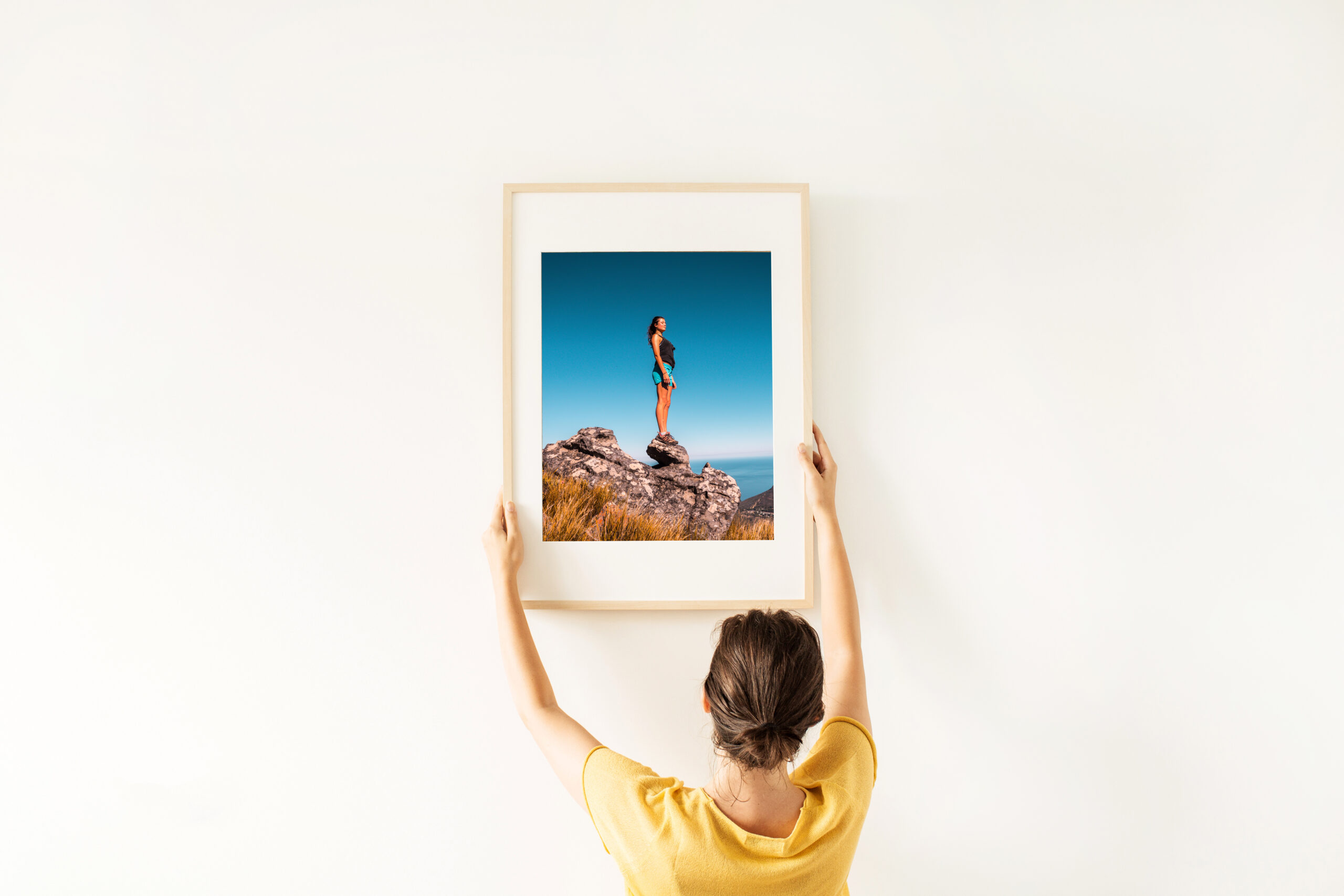
How to frame your art
Both the colour and shape of a frame are distinctive features that will enhance and complement your art. Spend the time to find the right one and there are inexpensive solutions.
What is the image focal point?
Full-bleed framing (the image sits edge to edge) is great for any print with a lot of negative (or empty) space. Adding an extra border (or Matt) around your photo can draw the eye towards the centre. The width of the border can be determined by balancing the space between the frame and image.
What’s the decor style of the room?
Choose from Rustic to Modern frame shapes and style to compliment the image and room and match the colour with one in your image or with your decor.

